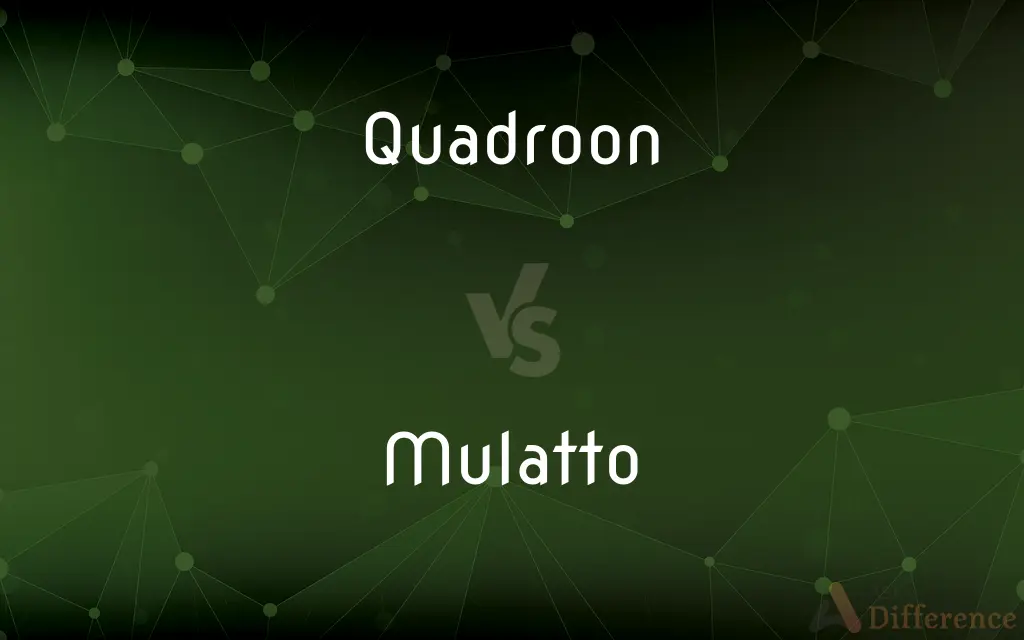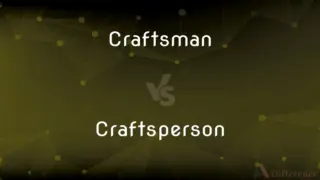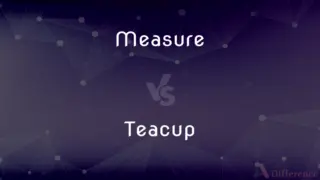Quadroon vs. Mulatto — What's the Difference?
By Tayyaba Rehman & Fiza Rafique — Updated on April 8, 2024
A Quadroon is an outdated term for someone with one-quarter African descent, whereas a Mulatto refers to a person with half African descent. Both terms are considered archaic and potentially offensive.

Difference Between Quadroon and Mulatto
Table of Contents
ADVERTISEMENT
Key Differences
A Quadroon is historically defined as an individual who has one African grandparent and three white grandparents, highlighting a specific fraction of African ancestry. This classification comes from a dated system of racial categorization. On the other hand, a Mulatto is defined as someone with one African parent and one white parent, emphasizing a 50% African descent. These terms were used primarily in contexts where the exact degree of African heritage was used to impose social and legal distinctions.
The term Quadroon was part of a lexicon that attempted to quantify African heritage in terms of discrete fractions, suggesting a perspective where racial identity was calculated rather than experienced. Whereas, the term Mulatto, while also quantifying African heritage, was used in a slightly broader social context, often without the same precision in ancestry but with similar implications for social status and identity.
Quadroon and Mulatto both stem from a racially stratified society where mixed ancestry was categorized to maintain a social hierarchy. While Quadroon indicates a lesser degree of African descent compared to Mulatto, both terms reflect a historical obsession with lineage and purity. This categorization had tangible impacts on individuals' rights, privileges, and social mobility.
These terms, Quadroon and Mulatto, not only differ in the specific degree of African ancestry they refer to but also in their historical and cultural implications. While both were used within a system of racial classification, the social and legal consequences for individuals labeled as such could vary significantly depending on the time and place.
Despite their historical usage, both Quadroon and Mulatto are now widely considered outdated and pejorative, as they reduce complex identities to simplistic racial fractions. Their use today is generally discouraged, reflecting a broader understanding and respect for racial and ethnic diversity beyond antiquated categories.
ADVERTISEMENT
Comparison Chart
Definition
One-quarter African descent
Half African descent
Ancestral Background
One African grandparent, three white grandparents
One African parent, one white parent
Historical Context
Used in a system categorizing mixed African descent
Broader use in racial categorization
Social Implications
Specific fraction indicating lesser African ancestry
Implies a 50/50 ancestry split
Current Acceptability
Considered outdated and potentially offensive
Also considered outdated and potentially offensive
Compare with Definitions
Quadroon
Reflects one-quarter African descent.
Her great-grandfather's history made her a Quadroon by old standards.
Mulatto
A person with one white and one African parent.
Being a Mulatto affected her social standing in the past.
Quadroon
Outdated and pejorative term.
The label Quadroon is now rightly seen as reductive and offensive.
Mulatto
Once a common term in racial categorization.
Mulatto was used to describe individuals of mixed heritage.
Quadroon
.
Mulatto
Signifies half African descent.
His mixed heritage was labeled as Mulatto in historical documents.
Quadroon
A person with one African grandparent.
He learned he was considered a Quadroon under historical classifications.
Mulatto
Considered derogatory and outdated.
The term Mulatto is now avoided for its simplistic view of race.
Quadroon
Historically, part of a racial categorization system.
Quadroon was a term used to define specific racial heritage.
Mulatto
Reflects a binary view of race.
As a Mulatto, he was caught between two worlds in societal perceptions.
Quadroon
Used in contexts of racial hierarchy.
As a Quadroon, his rights were different under the law historically.
Mulatto
Mulatto (, ) is a racial classification to refer to people of mixed African and European ancestry. Its use is considered outdated and offensive.
Quadroon
In the slave societies of the Americas, a quadroon or quarteron was a person with one quarter African and three quarters European ancestry. Similar classifications were octoroon for one-eighth black (Latin root octo-, means "eight") and hexadecaroon for one-sixteenth black.
Mulatto
A person of mixed white and black ancestry, especially one having one white and one black parent.
Quadroon
A person having white ancestors except for one black grandparent. Used especially as a classification under certain European colonial legal systems and now considered offensive.
Mulatto
A person of mixed black and white descent, especially a person with one black and one white parent or two mulatto parents.
Quadroon
A person considered three-fourths white, having one non-white grandparent.
Mulatto
The offspring of a negress by a white man, or of a white woman by a negro, - usually of a brownish yellow complexion.
Quadroon
Of or related to quadroons.
Mulatto
An offspring of a Black and a White parent
Quadroon
An offspring of a Mulatto and a White parent; a person who is one-quarter Black
Common Curiosities
What is a Quadroon?
A Quadroon is someone with one-quarter African descent, historically used to categorize people of mixed ancestry.
What does Mulatto mean?
Mulatto refers to a person of half African and half white ancestry, an outdated term once used for racial classification.
Why are the terms Quadroon and Mulatto considered offensive?
They simplify complex identities into racial fractions, reinforcing outdated notions of racial purity and hierarchy.
Are the terms Quadroon and Mulatto still acceptable to use?
No, both terms are considered outdated and potentially offensive, reflecting a bygone era of racial categorization.
Can someone be both Quadroon and Mulatto?
No, as each term denotes a specific fraction of African descent.
Was there a legal difference between Quadroons and Mulattos?
Yes, in certain times and places, the legal rights and social statuses of Quadroons and Mulattos differed significantly.
Are there any modern equivalents to Quadroon and Mulatto?
Modern discussions of race and identity prefer terms that respect the complexity of ancestry without reducing it to fractions.
Did Quadroon and Mulatto have different social implications?
Yes, the terms implied different levels of African descent, which could affect social standing and rights historically.
How were Quadroon and Mulatto used historically?
They were part of a racial classification system, with social and legal implications based on the degree of African ancestry.
What historical consequences did Quadroons and Mulattos face?
They often faced legal and social discrimination, with rights and statuses varying based on their racial classification.
What replaced the use of terms like Quadroon and Mulatto?
Today, more respectful and nuanced understandings of racial and ethnic identity are used, avoiding simplistic categorizations.
How did someone qualify as a Quadroon?
Historically, by having one African grandparent and three white grandparents.
How did the Quadroon and Mulatto classifications affect identity?
They imposed narrow identities on individuals, often affecting their self-perception and social interactions.
Why is it important to understand the terms Quadroon and Mulatto today?
Understanding these terms helps recognize the historical complexities of race and the ongoing impact of racial categorization.
How do Quadroon and Mulatto reflect the history of racial classification?
They showcase the extensive lengths to which societies went to categorize and control populations based on ancestry.
Share Your Discovery

Previous Comparison
Craftsman vs. Craftsperson
Next Comparison
Measure vs. TeacupAuthor Spotlight
Written by
Tayyaba RehmanTayyaba Rehman is a distinguished writer, currently serving as a primary contributor to askdifference.com. As a researcher in semantics and etymology, Tayyaba's passion for the complexity of languages and their distinctions has found a perfect home on the platform. Tayyaba delves into the intricacies of language, distinguishing between commonly confused words and phrases, thereby providing clarity for readers worldwide.
Co-written by
Fiza RafiqueFiza Rafique is a skilled content writer at AskDifference.com, where she meticulously refines and enhances written pieces. Drawing from her vast editorial expertise, Fiza ensures clarity, accuracy, and precision in every article. Passionate about language, she continually seeks to elevate the quality of content for readers worldwide.














































